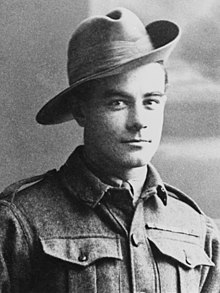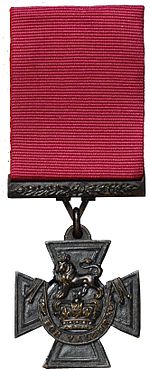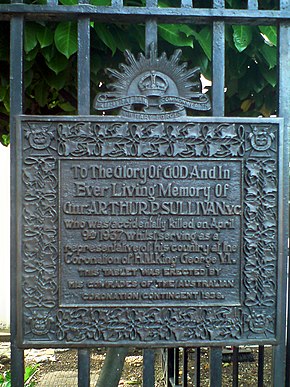Arthur Sullivan (Australian soldier)
Arthur Sullivan | |
|---|---|
 Sullivan c. 1919 | |
| Born | 27 November 1896 Prospect, South Australia |
| Died | 9 April 1937 (aged 40) Westminster, United Kingdom |
| Allegiance |
|
| Service/ |
|
| Years of service | 1918–1919 |
| Rank | Corporal |
| Unit |
|
| Battles/wars | |
| Awards | Victoria Cross |
| Spouse(s) |
Dorothy Frances Veale
(m. 1928) |
| Children | 3 |
Arthur Percy Sullivan
Sullivan was deployed to northern Russia with the relief force. Following a successful attack, he was a member of the
Early life
Arthur Percy Sullivan was born on 27 November 1896 at Prospect, South Australia,[a] the only child of Arthur Monks Sullivan, a storekeeper, and his wife Eliza née Dobbs of Crystal Brook in the mid-north of the state.[1][3] Beginning on 9 February 1904,[8] he was educated at Crystal Brook Public School and from 1910 at Gladstone High School where he was the school captain.[7][9][10] Sullivan was also editor of the school magazine and the best Australian rules football player for his school.[11]
After completing his education in mid-1913, he gained employment at a branch of the
Military service
World War I
On 27 April 1918, Sullivan attended a fund-raising parade in
Russia
While posted to the camp at
The NRRF was an 8,000-strong force of two

Sullivan sailed directly from
Dvina offensive
In August the NRRF was ordered to advance 150 miles (240 km) down the Dvina River to attack the Bolsheviks.
Sludka was the column's first objective, but on 9 August, scouts reported that the location of a swamp made a direct attack on the village impossible. As a result, the column pushed further south to attack the village of Kochamika, after which they would turn north and capture Sludka. The approach march began at 06:00 on 10 August, and the men slogged through the mud to positions at the edge of the forest by 11:00. Thirty minutes later, the British artillery, the river flotilla and aircraft began bombarding Kochamika. At 12:00, the D Company column, which included Sullivan's 16 Platoon, launched its assault, although without the support of the mountain guns and cavalry that had been left behind owing to the difficult terrain. With bayonets fixed, the force easily put the stunned Bolshevik defenders to flight. As soon as the village was taken, they came under fire from the Bolshevik river flotilla.[44][45]

D Company then pushed northwards, capturing several hamlets and many Bolshevik prisoners, although D Company's commander was killed by river gunboat fire. After scouting out Sludka, a successful assault was mounted on that village as well, while another column led by A Company captured Lipovets. The D Company column then joined A Company at Lipovets aiming to then reunite with the rest of the force, which had been unsuccessfully attacking the village of Seltso from the north. The Bolsheviks landed around 100 sailors between the two Allied columns, cutting off the southerly column including A and D Companies. Without their commander and running low on ammunition, the remaining officers decided to try to break out rather than push on towards Seltso.
About 02:30 on 11 August, having covered 12 miles (20 km) in eight hours, the column crossed the Sheika River, which at this point resembled a deep swamp about 330 feet (100 m) wide. The crossing was over a crude single-plank bridge. Sullivan's platoon was holding the near bank. As the long column crossed in single file, it was hit by Bolshevik rifle and machine gun fire at a range of less than 330 feet (100 m). The fire from the ambush increased as the rearguard crossed, and four men fell into the swamp and were in danger of drowning owing to exhaustion. Despite the intense Bolshevik gunfire and already nearly across the river himself, Sullivan immediately set about rescuing them.[1][7][25][48][49] The first man that Sullivan saved from the swamp was Lieutenant Charles Henry Gordon-Lennox, Lord Settrington, who had been wounded prior to falling off the bridge. He was the eldest son of the 8th Duke of Richmond and heir to the dukedoms of Richmond, Lennox and Gordon. He died of his wounds two weeks later in hospital at Bereznik. The second and third soldiers rescued were similarly pulled out of the swamp by Sullivan after either being hit or avoiding enemy fire. The fourth man was some distance away and Sullivan waded out with a piece of broken handrail from the temporary bridge that the soldier was able to grab and be pulled to safety.[7][50] All four would have drowned without Sullivan's action.[25] The fusiliers returned fire from the far bank, and suppressed the Bolshevik fire. After the river crossing, some members of the column broke off into smaller groups, but all remaining members made their way back to the British lines at Troitsa about 07:00. Total British casualties during the overall attack were less than 30 killed with over 100 wounded.[51][52]
For his actions on 11 August, Sullivan was recommended for the Victoria Cross (VC),[4] the highest award for gallantry in the face of the enemy that can be awarded to a member of the British armed forces.[53] Two other Australians were awarded the Distinguished Conduct Medal (DCM), second only to the VC, for their actions at the river crossing.[54]

British forces successfully evacuated from North Russia by late September, leaving Troitsa by 10 September, and sailing from Archangel on 27 September, with Sullivan having spent 100 days in Russia.[55][56] On 26 September, Sullivan's VC was formally announced in The London Gazette. The citation read:[57][58][59][c]
For most conspicuous bravery and devotion to duty on the 10th August, 1919 at the Sheika River, North Russia. The platoon to which he belonged, after fighting a rearguard covering action, had to cross the river by means of a narrow plank, and during the passage an officer and three men fell into a deep swamp. Without hesitation, under intense fire, Corporal Sullivan jumped into the river and rescued all four, bringing them out singly. But for this gallant action his comrades would undoubtedly have been drowned. It was a splendid example of heroism, as all ranks were on the point of exhaustion and the enemy less than 100 yards distant.
— The London Gazette 26 September 1919
When told of his award, Sullivan said that his comrades were also worthy of recognition and stated that his VC should be raffled, although the latter did not occur.[60]
Return to Australia
The Australians arrived in Plymouth on 9 October, and were then sent to a repatriation camp near Winchester.[61] After a rowdy night out on leave following their arrival, a British sergeant tried to get the names of all the miscreants in his notebook. When questioned about his name, Sullivan replied, "Corporal Sullivan VC to you, you pommie bastard".[62] Despite the insubordination, no action was taken against him. Sullivan gave only one interview about his VC exploits, and was modest and unassuming, saying that it was "not much to talk about", and that he had been lucky.[62] He remained reluctant to talk about his VC actions, and became known as the "Shy VC".[63]
The NRRF was demobilised upon its return to the UK. Sullivan wished to return to Australia immediately without waiting for his
On hearing of his VC, the National Bank decided to give Sullivan a
Later life
Arthur Sullivan was a very popular man, and his reputation as the "Shy VC" was enhanced by his "unassuming character and reluctance to talk of his exploits".
In 1929 he transferred to the bank's head office in
Australian Coronation Contingent
In 1937, Sullivan was selected to join the Australian contingent to attend the

Oronsay sailed via Adelaide,
On 9 April 1937, a little over a month before
In the wake of Sullivan's death, the ACC cancelled all their scheduled activities for three days, including an honour guard they were to mount for the arrival in London of the ACC commander, General Sir
Legacy
After lying in state with an ACC
The National Bank of Australasia gave Dorothy a gratuity of £250, sufficient to purchase a cottage near Manly so she could be close to friends and family.[91] In March 1939, Sullivan's mother presented an enlarged photograph of her son to the Crystal Brook Primary School.[9] In the same year, a bronze plaque was made by a member of the ACC, but owing to World War II it was not placed upon the iron railings of Wellington Barracks, close to where Sullivan was killed, until January 1946.[92] Dorothy attended the 1956 VC centenary celebrations in London,[25] with her travel costs picked up by the National Bank of Australasia.[91] When she died in 1980, she left his medal set, including the VC and King George VI Coronation Medal, to the Australian War Memorial in Canberra. They are displayed in the Hall of Valour.[1][2][4] In 1996, the Vietnam veteran Keith Payne VC unveiled a plaque in Crystal Brook dedicated to him.[93] In 2015, a memorial to Sullivan was unveiled in Crystal Brook.[1] His name is inscribed on the Maitland War Memorial.[94]
Notes
- ^ Staunton, Quinlivian and the Australian War Memorial give his place of birth as Prospect,[1][2][3][4] but this is contradicted by Wigmore & Harding and South Australian Births, Deaths and Marriages data, which state he was born in Crystal Brook.[5][6] Blanch and Pegram are silent on the issue.[7]
- ^ Staunton, Wigmore & Harding, and the Australian War Memorial give his AIF discharge date as 12 June,[1][2][4][5] but this is contradicted by his discharge certificate which says 28 May.[29]
- ^ The citation states that his actions took place on 10 August, but this is an error.[60]
Footnotes
- ^ a b c d e f g h i j k l m n o p q r Staunton 1990.
- ^ a b c d e f g h i j Staunton 2005, p. 201.
- ^ a b Quinlivian 2006, p. 18.
- ^ a b c d e f g h i j k l m n o p q r s t u Australian War Memorial 2019.
- ^ a b c d Wigmore & Harding 1986, p. 134.
- ^ SA BDM 2019.
- ^ a b c d e f g h i Blanch & Pegram 2018, p. 326.
- ^ Quinlivian 2006, p. 19.
- ^ a b The Recorder 20 March 1939.
- ^ Challinger 2010, p. 199.
- ^ Quinlivian 2006, p. 20.
- ^ Quinlivian 2006, pp. 20–22.
- ^ Quinlivian 2006, p. 33.
- ^ Quinlivian 2006, p. 49.
- ^ Quinlivian 2006, p. 58.
- ^ Quinlivian 2006, pp. 61–62, 66–67.
- ^ Quinlivian 2006, pp. 68–70.
- ^ Quinlivian 2006, p. 73.
- ^ National Archives 2019a, pp. 8 & 23.
- ^ Challinger 2010, p. 200.
- ^ Quinlivian 2006, p. 82.
- ^ National Archives 2019a, p. 24.
- ^ Challinger 2010, p. 82.
- ^ National Archives 2019a, p. 42.
- ^ a b c d e f g h i Wigmore & Harding 1986, p. 135.
- ^ Challinger 2010, pp. 81–82.
- ^ Quinlivian 2006, p. 88.
- ^ Quinlivian 2006, pp. 109 & 113.
- ^ a b National Archives 2019a, p. 35.
- ^ Quinlivian 2006, opposite p. 256.
- ^ Challinger 2010, p. 100.
- ^ Challinger 2010, pp. 85–86.
- ^ Quinlivian 2006, p. 126.
- ^ Quinlivian 2006, pp. 128–129.
- ^ Quinlivian 2006, p. 132.
- ^ Challinger 2010, pp. 101–105.
- ^ Quinlivian 2006, p. 133.
- ^ Challinger 2010, pp. 105–109.
- ^ Challinger 2010, pp. 109–114.
- ^ Quinlivian 2006, p. 148.
- ^ Quinlivian 2006, p. 135.
- ^ Challinger 2010, pp. 146–148.
- ^ Quinlivian 2006, p. 149.
- ^ Challinger 2010, pp. 149–152.
- ^ Quinlivian 2006, pp. 150–151.
- ^ Challinger 2010, pp. 152–153.
- ^ Quinlivian 2006, p. 152.
- ^ Quinlivian 2006, p. 153.
- ^ Brazier 2010, p. 298.
- ^ Challinger 2010, p. 155.
- ^ Quinlivian 2006, pp. 154–155.
- ^ Challinger 2010, pp. 155–158.
- ^ Wigmore & Harding 1986, p. 9.
- ^ Challinger 2010, p. 159.
- ^ Quinlivian 2006, pp. 163 & 167.
- ^ Challinger 2010, pp. 179–183.
- ^ The London Gazette 26 September 1919.
- ^ National Archives 2019b, p. 2.
- ^ Blanch & Pegram 2018, p. 325.
- ^ a b Quinlivian 2006, p. 165.
- ^ Quinlivian 2006, p. 175.
- ^ a b Quinlivian 2006, p. 178.
- ^ Quinlivian 2006, p. 179.
- ^ Quinlivian 2006, pp. 182, 184 & 189.
- ^ Quinlivian 2006, p. 191.
- ^ Quinlivian 2006, p. 184.
- ^ Quinlivian 2006, p. 202.
- ^ Quinlivian 2006, p. 193.
- ^ Quinlivian 2006, pp. 208–210.
- ^ Quinlivian 2006, pp. 212–214.
- ^ Quinlivian 2006, pp. 215–219.
- ^ Quinlivian 2006, p. 210.
- ^ Quinlivian 2006, p. 219.
- ^ Quinlivian 2006, pp. 223–231.
- ^ a b Quinlivian 2006, p. 233.
- ^ a b Quinlivian 2006, p. 239.
- ^ Challinger 2010, p. 205.
- ^ Quinlivian 2006, p. 241.
- ^ Challinger 2010, p. 206.
- ^ Quinlivian 2006, pp. 243–247.
- ^ Quinlivian 2006, p. 251.
- ^ Quinlivian 2006, pp. 252–253.
- ^ Quinlivian 2006, p. 257.
- ^ Challinger 2010, p. 207.
- ^ Quinlivian 2006, pp. 258–259.
- ^ Challinger 2010, pp. 205 & 207.
- ^ Quinlivian 2006, pp. 259–261 & 264.
- ^ Kalgoorlie Miner 1937.
- ^ Quinlivian 2006, pp. 264–267.
- ^ The Sydney Morning Herald 1937.
- ^ a b Quinlivian 2006, p. 276.
- ^ Quinlivian 2006, pp. 270–271.
- ^ Quinlivian 2006, p. 273.
- ^ Quinlivian 2006, p. 211.
References
- "Australian Soldier's Death". Kalgoorlie Miner. Vol. 43, no. 10, 922. Western Australia. 14 April 1937. p. 5. Retrieved 22 October 2020.
- Blanch, Craig; Pegram, Aaron (2018). For Valour: Australians Awarded the Victoria Cross. Sydney, New South Wales: NewSouth Publishing. ISBN 978-1-74223-542-4.
- Brazier, Kevin (2010). The Complete Victoria Cross. Barnsley, UK: Pen & Sword Military. ISBN 978-1-84884-150-5.
- Challinger, Michael (2010). Anzacs in Arkhangel. The Untold Story of Australia and the Invasion of Russia 1918–19. Prahran, Victoria: Hardie Grant. ISBN 978-1-74066-751-7.
- "Coronation Troops". The Sydney Morning Herald. No. 31, 043. New South Wales, Australia. 1 July 1937. p. 12. Retrieved 22 October 2020.
- "Honoring Memory of Cpl. Arthur Sullivan, V.C." The Recorder. No. 12, 461. Port Pirie, South Australia. 20 March 1939. p. 2. Retrieved 25 May 2019.
- "NAA: B2455, Sullivan, Arthur Percy". National Archives of Australia. Retrieved 23 May 2019.
- "NAA: MT1487/1, Sullivan/AP". National Archives of Australia. 4 February 1920. Retrieved 23 May 2019.
- "No. 31572". The London Gazette (Supplement). 26 September 1919. p. 11997.
- Quinlivian, Peter (2006). Forgotten Valour: The Story of Arthur Sullivan VC. Frenchs Forest, New South Wales: New Holland. ISBN 978-1-74110-486-8.
- Staunton, Anthony (1990). "Arthur Percy Sullivan (1896–1937)". Sullivan, Arthur Percy (1896–1937). Vol. 12. Canberra: Australian National University. Retrieved 12 June 2013.
{{cite book}}:|website=ignored (help) - Staunton, Anthony (2005). Victoria Cross: Australia's Finest and the Battles they Fought. Prahran, Victoria: Hardie Grant. ISBN 978-1-74273-486-6.
- "Sullivan, Arthur Percy". Genealogy SA. Retrieved 25 May 2019.
- "Victoria Cross: Corporal A P Sullivan, 45 Battalion, Royal Fusiliers". Australian War Memorial. Retrieved 23 May 2019.
- ISBN 978-0-642-99471-4.
Further reading
- Wright, Damien (2017). Churchill's Secret War with Lenin: British and Commonwealth Military Intervention in the Russian Civil War, 1918–20. Solihull, UK: Helion. ISBN 978-1-91151-210-3.
